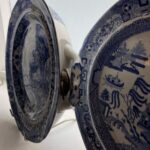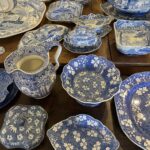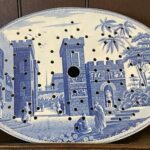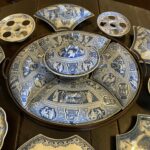Since moving to Stoke, I have been fascinated by the architectural landscape around me, indicative of the city’s rich history. I have thoroughly enjoyed visits to the remaining pot banks, where exhibits detail the industrial development of the city’s six towns, their social history, and the skilled techniques that were used.
At Spode, ‘the blue room’ houses a collection of the factory’s famous blue and white bone china from across time. This was a method of decoration using designs that were etched onto copper plates, printed with oil-based ink onto tissue paper, before being pressed onto the white of the pots. Spode have retained an enormous collection not only of this pottery, but also the copper plates themselves – of which they have some 50,000.
The vast range of the forms in the blue room is eye-opening to the feasting habits of the time, and the status symbol these luxury items had. My favourites were a five piece lidded dinner set, an enormous meat draining board, and ‘invalid plates’, which are essentially a plate sat upon and fused to a shallow dish, with a spout for inserting hot water to keep the meal warm (the hot-water bottle of crockery, and it can’t have been that hygienic!). Although these vessels may appear outdated to contemporary taste, it feels important not to dismiss them as relics of the past, especially as the skills and knowledge needed to produce such wares are on the precipice of extinction.




Camille Biddell


